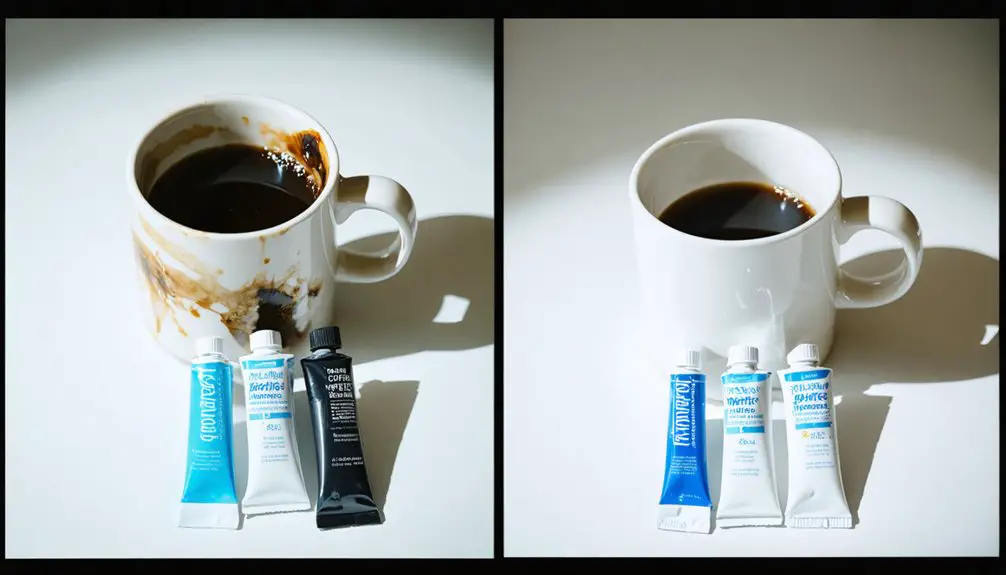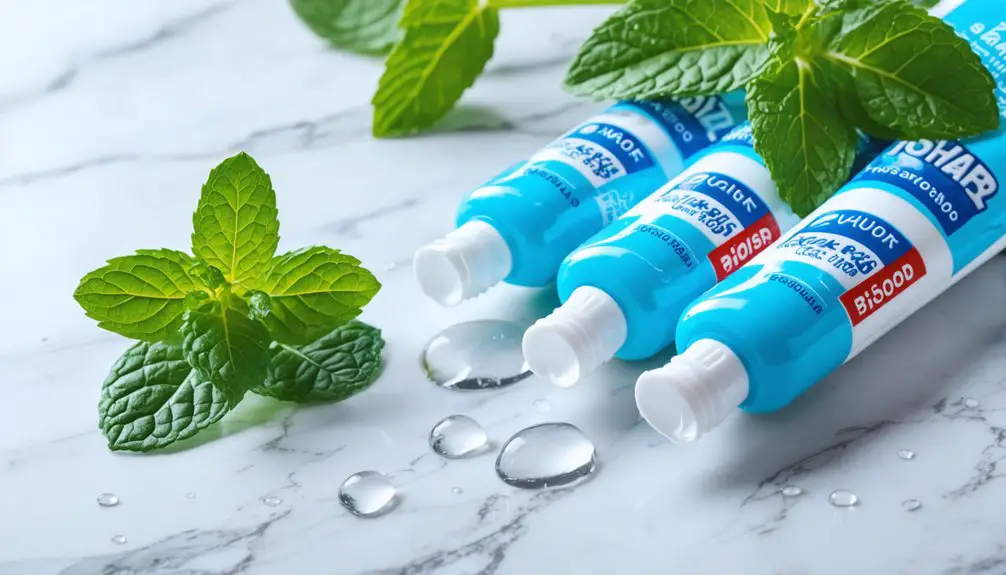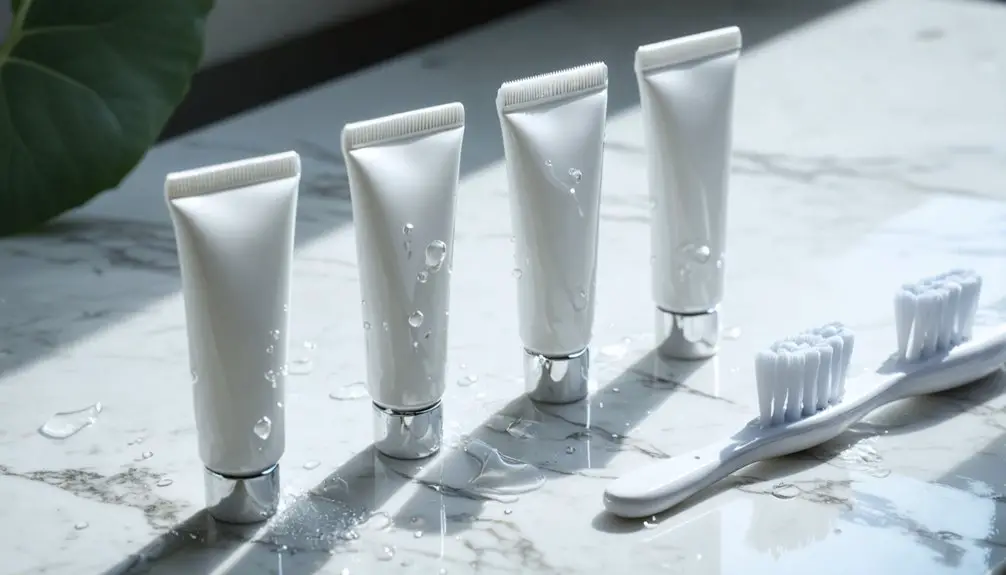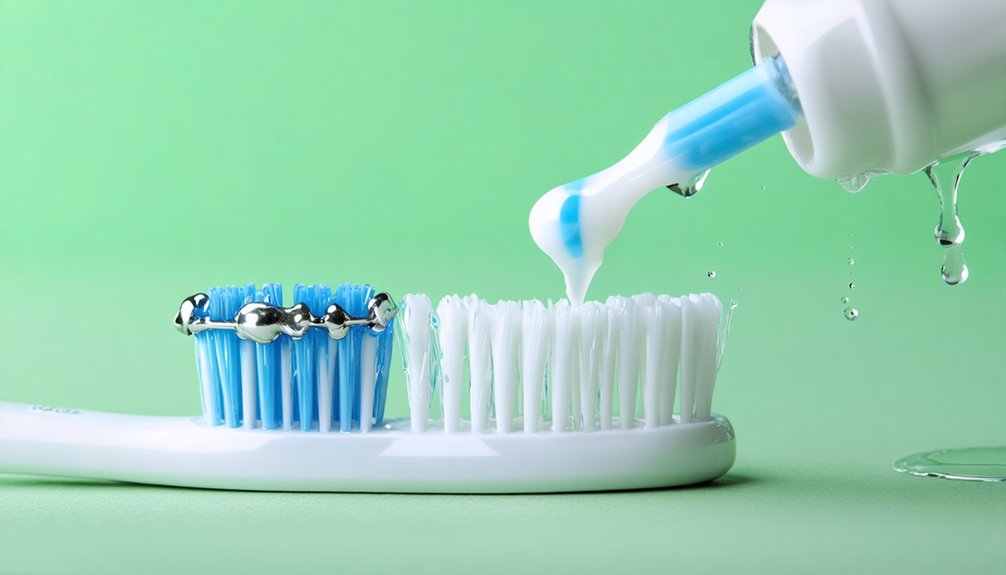For removing age-related tooth stains, you’ll find Crest 3D White Brilliance and Colgate Optic White Advanced most effective, as they remove up to 95% of surface discoloration. These toothpastes contain specialized whitening agents that target deep-set stains while protecting enamel. If you have sensitive teeth, consider Sensodyne Clinical White, which offers both stain removal and nerve protection. Understanding the causes of age stains can help you choose the most suitable whitening solution.
Key Takeaways
- Crest 3D White Brilliance and Colgate Optic White Advanced are most effective, removing up to 95% of surface stains.
- Choose toothpaste with gentle abrasives like silica and mica, plus hydrogen peroxide for breaking down stubborn age-related stains.
- For sensitive teeth, Sensodyne Clinical White provides both stain removal and nerve protection while strengthening aging enamel.
- Look for formulas containing chelating agents and sodium pyrophosphate to prevent stains from redepositing on teeth.
- Limit whitening toothpaste use to once weekly and combine with regular fluoride toothpaste to protect enamel integrity.
Understanding Age-Related Tooth Stains and Their Causes
As your teeth age naturally over time, complex biological and environmental factors work together to create visible discoloration and staining.
Your enamel gradually thins while the dentin beneath darkens and thickens, leading to inevitable changes in tooth color during the aging process. Dark beverages like coffee and tea are major contributors to surface staining.
As tooth enamel wears away with age, the darkening dentin layer underneath becomes more visible, naturally changing your smile’s appearance.
You’ll notice these changes accelerate due to multiple factors: decreased saliva production reduces your teeth’s natural protection, while long-term exposure to pigmented foods, beverages, and medications leaves lasting marks.
Your genetic predisposition plays a significant role too, particularly if you’ve inherited thinner enamel or more porous tooth structure.
Medical treatments, certain antibiotics, and lifestyle choices like smoking can further compound these effects. Patients taking antipsychotic medications often experience tooth discoloration as an unfortunate side effect.
Understanding these underlying causes helps you better address age-related tooth discoloration through appropriate oral care strategies.
Essential Ingredients That Combat Stubborn Age Stains
When choosing a toothpaste to combat age-related stains, you’ll need specific ingredients that work synergistically to remove, prevent, and protect against discoloration. Regular brushing with these formulations shows gradual brightness improvement.
The most effective formulations combine gentle abrasive agents like silica and ethically-sourced mica with proven whitening ingredients such as hydrogen peroxide. These work alongside chelating agents and natural antioxidants to break down stubborn stains while protecting your enamel. The unique Elixir X blend provides comprehensive antioxidant protection through its proprietary combination of 10 essential oils.
- High-cleaning silica (10%) provides mechanical stain removal without excessive abrasion
- Sodium pyrophosphate and phytate prevent stain redeposition and calculus buildup
- Peroxide-based whitening ingredients break down deep-set chromophores
- Natural extracts offer antioxidant protection and antimicrobial benefits
- Enamel-safe surfactants and potassium nitrate reduce sensitivity while maintaining cleaning power
Top-Rated Whitening Toothpastes for Mature Teeth
While mature teeth require special attention for whitening, several top-rated toothpastes effectively balance stain removal with enamel protection. Regular use of these products leads to best visible results. Dentists recommend using whitening toothpaste no more than once weekly to protect enamel integrity.
For ideal whitening effectiveness, you’ll find Crest 3D White Brilliance and Colgate Optic White Advanced leading the peroxide-based options, removing up to 95% of surface stains.
However, if you’re treating sensitive teeth, Sensodyne Pronamel Gentle Whitening and Sensodyne True White offer safer alternatives with proven ingredient safety profiles. These formulations use potassium nitrate and lower RDA values to protect delicate enamel while gradually lifting stains.
For those preferring natural options, Tom’s of Maine Fluoride-Free Antiplaque & Whitening provides gentle stain removal using silica and xylitol.
Remember to take into account toothpastes containing hydroxyapatite or fluoride, as these ingredients help strengthen aging enamel while enhancing whitening results.
Protecting Sensitive Teeth While Removing Stains
Because sensitive teeth require specialized care during whitening treatments, you’ll need toothpaste that balances stain removal with nerve protection.
Look for formulas containing fluoride and remineralizing agents that strengthen enamel while providing sensitivity relief. Modern whitening toothpastes specifically designed for sensitive teeth often avoid harsh abrasives and hydrogen peroxide, instead using gentle chemical agents to dissolve stains without compromising comfort. Sensodyne Clinical White provides 24/7 sensitivity protection while effectively whitening teeth. As the #1 dentist recommended brand for sensitive teeth, Sensodyne consistently delivers proven results.
- Choose products free from SLS and harsh abrasives to minimize gum irritation
- Select toothpastes with extra-strength fluoride for enhanced enamel protection
- Opt for formulas that offer 24/7 sensitivity relief while whitening
- Consider triple-action products that whiten, polish, and protect simultaneously
- Use toothpastes containing stain-fighting agents that create protective barriers against new discoloration
Daily Dental Care Tips for Long-Term Stain Prevention
Long-term stain prevention demands a thorough daily dental care strategy that extends beyond basic brushing and flossing.
You’ll need to establish consistent preventive habits that protect your teeth throughout the day. Brush twice daily with fluoride toothpaste using a soft-bristled or electric toothbrush, and floss thoroughly to remove hidden debris between teeth. Maintaining good oral hygiene helps eliminate both existing and new stains on your teeth. A patient-focused approach ensures your dental care routine matches your specific needs.
Your dietary choices play a significant role in maintaining stain-free teeth. Limit exposure to staining beverages like coffee and wine by using a straw, and rinse your mouth with water immediately after consuming pigmented foods.
Mindful eating habits are essential for whiter teeth – choose beverages wisely and rinse after consuming foods that could stain.
Choose crunchy fruits and vegetables that naturally clean teeth while eating, and chew sugar-free gum after meals to stimulate protective saliva production.
Remember to schedule regular dental cleanings to professionally remove stubborn stains that daily care can’t address.
Frequently Asked Questions
How Long Should I Wait After Eating Before Using Whitening Toothpaste?
You’ll want to wait 30-60 minutes after eating before using whitening toothpaste for ideal effectiveness. For acidic or staining foods, wait the full hour to protect your enamel and maximize whitening results.
Can Whitening Toothpaste Remove Coffee Stains From Dental Crowns or Veneers?
No, whitening ingredients won’t effectively remove coffee stains from crowns or veneers since they’re non-porous. You’ll need professional dental crown care and polishing to restore their appearance.
Is It Safe to Use Whitening Toothpaste Twice Daily?
You can safely use whitening toothpaste twice daily, but monitor for sensitivity concerns. If discomfort occurs, consider natural alternatives like papaya-based formulas while maintaining your regular dental hygiene routine.
Should Whitening Toothpaste Be Used With an Electric or Manual Toothbrush?
Like a race car’s power versus a reliable bicycle, electric toothbrush benefits include superior stain removal, while manual toothbrush effectiveness offers gentler cleaning. You’ll get results with either, but electric’s more efficient.
Can Medication-Induced Tooth Discoloration Be Removed With Whitening Toothpaste?
You won’t effectively remove medication-induced tooth discoloration with whitening toothpaste alone, as various medication types cause intrinsic staining below your enamel’s surface. Professional dental treatments are necessary for meaningful results.
References
- https://moonoralbeauty.com/products/stain-removal-whitening-toothpaste
- https://nhdentistrybeverlyhills.com/press/the-5-best-whitening-toothpastes-according-to-a-cosmetic-dentist/
- https://www.the-independent.com/extras/indybest/fashion-beauty/beauty/best-whitening-toothpaste-uk-reviews-b1783716.html
- https://myprivatedentist.com/best-toothpaste/
- https://rembrandt.com/products/whtn-pst-intense-stain-3-5-oz?bvstate=pg:4/ct:r
- https://altrockfabbdental.com/why-do-teeth-become-discolored-with-age/
- https://unionsquaredentalny.com/why-do-teeth-lose-their-whiteness-as-you-age/
- https://www.listerine.com/teeth-whitening/causes-yellow-teeth
- https://www.tlnfamilydental.com/post/why-do-teeth-become-discolored-with-age
- https://my.clevelandclinic.org/health/symptoms/10958-tooth-discoloration



